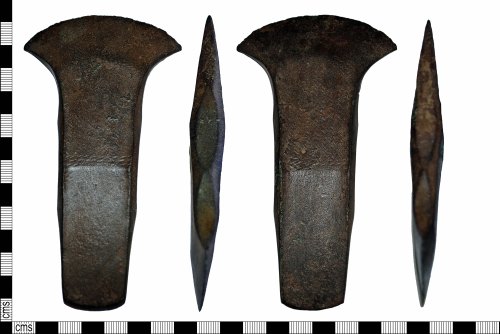
Rights Holder: The Portable Antiquities Scheme
CC License: ![]()
Image use policy
Our images can be used under a CC BY attribution licence (unless stated otherwise).
FLAT AXEHEAD
Unique ID: LANCUM-FF1A46
Object type certainty: Certain
Workflow
status: Published ![]()
A complete Early Bronze Age cast copper-alloy undecorated developed flat axe (c. 2000-1700 BC): This implement is sub-rectangular in plan with an expanded crescent shaped blade. The butt, in plan, is complete with a rounded terminal. The side profile of the axe is lentoid with both terminals tapering. In cross section the body of the axe has lentoid profile. The axe is decorated with short incised probably chiselled lines below the stop ridge and along the length to the blade. The butt end of the axe has been hammered flat creating a proto-stop ridge. The blade tip flares outwards from the body forming a concave hollow. The blade appears to be symmetrical. There is an obvious cutting edge bevel towards the blade edge where it has been hammered for sharpening. The surface of the axe has a dark greenish-brown patina. The length is 133mm, the width of blade is 78mm, width of butt is 28mm, thickness 18mm.
The axehead is best described as coming from the later phases of the Early Bronze Age (EBA III) of metalworking stage IV-V (more likely V) specifically within the developed flat axe tradition which corresponds to Needham's (1996) Period 3 circa 2000 - 1700 CAL.BC. This axe is very similar to a number of examples specifically from the type: Brandon. These are described by Burgess and Schmidt in Catalogue of the Axes in Northern Britain as: being "notably smaller than other advanced flat axes, usually under 130mm length. They have straight parallel or near parallel sides which curve out suddenly just above the blade to a widely expanded crescentic cutting edge. The decoration could reveal an Irish influence.
Class: Needham's (1996) Period 3 circa 2000 - 1700 CAL.BC.
Subsequent actions
Subsequent action after recording: Returned to finder
Chronology
Broad period: BRONZE AGE
Period from: BRONZE AGE
Subperiod to: Early
Period to: BRONZE AGE
Date from: Circa 2000 BC
Date to: Circa 1700 BC
Dimensions and weight
Quantity: 1
Length: 133 mm
Width: 78 mm
Thickness: 18 mm
Discovery dates
Date(s) of discovery: Thursday 1st June 2017 - Thursday 1st June 2017
Personal details
This information is restricted for your access level.
Materials and construction
Spatial metadata
Region: North West (European Region)County or Unitary authority: Lancashire (County)
District: Ribble Valley (District)
Parish or ward: Pendleton (Civil Parish)
Spatial coordinates
4 Figure: SD7539
Four figure Latitude: 53.84663226
Four figure longitude: -2.38146836
1:25K map: SD7539
1:10K map: SD73NE
Grid reference source: From finder
Unmasked grid reference accurate to a 1 metre square.
References cited
No references cited so far.
Similar objects

Find number: LANCUM-1C4D1C
Object type: FLAT AXEHEAD
Broadperiod: BRONZE AGE
A complete Early Bronze Age cast copper-alloy undecorated developed flat axe (c. 2000-1700 BC): This implement is sub-rectangular in plan wit…
Workflow: Published![]()

Find number: SWYOR-8A8C71
Object type: FLAT AXEHEAD
Broadperiod: BRONZE AGE
A complete Early Bronze Age cast copper-alloy undecorated developed flat axe dating from about 2000-1700 BC. The axe is sub-rectangular in pl…
Workflow: Awaiting validation![]()

Find number: WAW-2779F8
Object type: FLAT AXEHEAD
Broadperiod: BRONZE AGE
A complete Early Bronze Age cast copper-alloy undecorated developed flat axe (c. 2000-1700 BC): This implement is sub-rectangular in plan wit…
Workflow: Awaiting validation![]()


